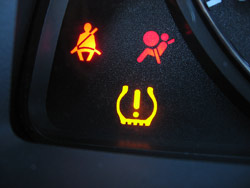TPMS: Headache or Life Saver?
That little light on your dashboard may be annoying, but it could save your life.
It's Monday morning, and you're running late to an important meeting. As you start your car, a light illuminates on your dashboard. "What is it now?" you think to yourself. Stepping out of the car, you realize your rear tire is very low on air. Better safe than sorry, you think, and wisely reinflate the tire before you get on the freeway. You may have arrived late, but thanks to your vehicle's Tire Pressure Monitoring System, you arrived in one piece.
The Tire Pressure Monitoring System (TPMS) continuously measures tire pressure at each wheel to ensure your safety. Tires must be inflated to the proper level to perform correctly and provide safe operation. Even a tire in perfect shape can lose between 3 and 9 psi of pressure per year, simply due to the nature of rubber. In spite of this, few drivers keep tabs on their tire pressure, and a tire that visually appears low on air is often already dangerously under inflated. Vehicles not protected by a Tire Pressure Monitoring System (TPMS) can also experience poor fuel economy due to under inflated tires.
To avoid these problems, your vehicle's TPMS system must be maintained. TPMS sensors are rugged, but contain batteries that must be replaced when they run out, and rubber seals that should be serviced every time a tire is changed. Additionally, when a vehicle is brought in for service, a TPMS reset must take place, often by following a manufacturer-specified TPMS relearn procedure. Specific tire pressure monitoring system tools are available to perform this task, which varies depending on the brand of vehicle and type of TPMS system it is equipped with. Performing a relearn procedure and keeping the TPMS sensors in good shape ensures that your vehicle's tire pressure monitoring system will continue to operate as specified and protect you and your vehicle for years to come.

